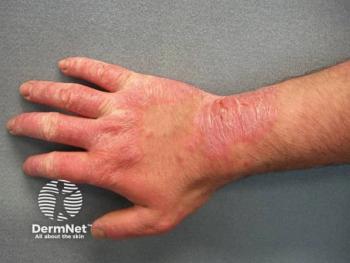
Uncovering Inequities in Hidradenitis Suppurativa Trials
Key Takeaways
- Hidradenitis suppurativa (HS) is under-recognized, with diagnostic delays exacerbating disease progression, especially in women and African Americans.
- HS patients experience significant psychosocial burdens, including elevated depression and anxiety rates, necessitating comprehensive care approaches.
Explore the critical need for diversity in hidradenitis suppurativa clinical trials to address health inequities and improve patient outcomes.
Despite being a clinically significant condition, hidradenitis suppurativa (HS) is frequently under-recognized, with an average diagnostic delay of 7 to 10 years. This lag can severely impair quality of life and exacerbate disease progression.1 The condition is more prevalent among women and African Americans, with some genetic cases inherited in an autosomal dominant fashion involving mutations in the γ-secretase complex.2 Prevalence estimates range from 0.05% to 4%, with underrepresented populations, particularly Black Americans, experiencing significant diagnostic delays—up to 2 years longer on average than White and Hispanic Americans.3 These disparities are compounded by limited access to dermatologic care and socioeconomic barriers.
Psychosocial Burden and Comorbidities
Patients with HS face substantial psychosocial challenges, including elevated rates of depression (26.5% vs. 6.6% in controls), anxiety (18.1% vs. 7.1%), substance use, and suicidality. The stigmatizing and often painful nature of HS contributes to these comorbidities, further highlighting the need for comprehensive, multidisciplinary care approaches.4
Addressing Health Inequities in Clinical Research
Health inequities in HS extend beyond clinical care into the realm of research. Populations disproportionately affected by HS—including racial and ethnic minorities and those of lower socioeconomic status—are underrepresented in clinical trials. Researchers behind recent research noted this raises critical concerns about the generalizability of findings and the equity of interventions derived from such studies.5
Study Objectives and Methodology
The cross-sectional analysis aimed to evaluate recruitment and retention strategies used in clinical trials focused on HS. Using PRISMA guidelines, researchers conducted systematic searches across Embase, MEDLINE, and ClinicalTrials.gov, focusing on studies from 2018 to 2023 conducted in diverse populations (EFI ≥ 0.3). Trials were assessed for inclusivity, recruitment efforts targeting underrepresented groups, and retention strategies.
Findings: Limited Inclusivity in Trial Design
Out of 36 trials included, only 1 explicitly reported implementing a recruitment strategy—and that was due to the COVID-19 pandemic. None of the studies stated diversity goals or documented challenges during the recruitment phase. Most trials were industry-funded (63.9%) and focused primarily on therapeutic interventions (97.2%). White participants dominated study cohorts, with minimal inclusion or reporting of Black, Hispanic, Asian, and Indigenous populations, despite HS being more prevalent among some of these groups.
Barriers to Participation and Reporting Deficiencies
The lack of reported recruitment strategies does not necessarily indicate their absence but rather a systemic failure to document and prioritize these aspects in published trials. This poor transparency limits reproducibility and undermines efforts to understand and address participation barriers. The CONSORT-Equity extension recommends that recruitment methods be explicitly reported in relation to equity factors—guidance that is frequently ignored.
Recommendations for Inclusive Research Practices
To foster equity in HS research, researchers stated trials must implement and report inclusive recruitment and retention strategies. Suggested methods include:
- Locating trials in underserved communities.
- Offering transportation, flexible scheduling, and financial incentives.
- Employing culturally tailored outreach and recruitment materials.
- Building community partnerships and applying field-based, culturally humble engagement practices.
These approaches not only enhance participation but also improve the applicability of findings to diverse populations.
Future Directions
Researchers suggested further research is needed to:
- Investigate participant perspectives from diverse backgrounds using ethnographic methods.
- Develop centralized repositories of effective recruitment strategies.
- Encourage policy and legislative changes that support inclusive clinical research.
Moreover, trial protocols should adopt standardized language guidelines, culturally competent frameworks, and accessible formats for participants with varying levels of health literacy.
Conclusion
HS remains a complex condition with significant diagnostic delays, psychosocial burdens, and systemic inequities in clinical research. The analysis’ findings underscore a major gap in the recruitment and retention practices of HS clinical trials, which undermines both the external validity of trial findings and the equitable development of treatments. Prioritizing diversity and inclusivity in trial design is not only ethically necessary—it is critical for improving dermatologic outcomes for all patients, particularly those historically marginalized.
References
- Aparício Martins I, Figueira Vilela B, Cabete J. Diagnostic delay in hidradenitis suppurativa: Still an unsolved problem. Skin Appendage Disord. 2024;10(2):129-132. doi:10.1159/000534845
- Von Der Werth JM, Williams HC, Raeburn JA. The clinical genetics of hidradenitis suppurativa revisited. Br J Dermatol. 2000;142(5):947-953. doi:10.1046/j.1365-2133.2000.03476.x
- Sayed CJ, Hsiao JL, Okun MM; Hidradenitis Suppurativa Foundation Women's Health Subcommittee. Clinical epidemiology and management of hidradenitis suppurativa. Obstet Gynecol. 2021;137(4):731-746. doi:10.1097/AOG.0000000000004321
- Caccavale S, Tancredi V, Boccellino MP, Babino G, Fulgione E, Argenziano G. Hidradenitis suppurativa burdens on mental health: A literature review of associated psychiatric disorders and their pathogenesis. Life (Basel). 2023;13(1):189. Published 2023 Jan 9. doi:10.3390/life13010189
- Marchbanks J, Bagaruka E, Ghebrehiwet M, et al. Examining recruitment and retention strategies in hidradenitis suppurativa clinical trials: A cross-sectional study. Dermatologic Therapy. 2025. doi: 10.1155/dth/9974685
Newsletter
Like what you’re reading? Subscribe to Dermatology Times for weekly updates on therapies, innovations, and real-world practice tips.



















